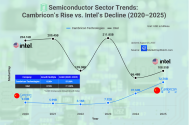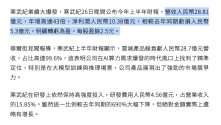Hengkun New Materials will enter the Sci-Tech Innovation Board (STAR Market)
Xiamen Hengkun New Materials Technology Co., Ltd. (hereinafter referred to as "Hengkun New Materials") will enter the Sci-Tech Innovation Board (STAR Market) with its "hard technology" DNA. As one of the few domestic companies to achieve mass production of key materials for 12-inch integrated circuit wafer manufacturing, Hengkun New Materials has not only been recognized as a national-level "Little Giant" for specialized, specialized, and innovative materials, but has also broken the monopoly of foreign giants in the fields of photolithography materials and precursor materials, achieving a leap from a "localization rate of less than 1%" to a "three-year compound growth rate of self-generated revenue of 67%."
Since its establishment in 2004, Hengkun New Materials has always focused on the research and development and industrialization of key materials for integrated circuits. It is one of the few innovative companies in China with the ability to research and develop and mass-produce key materials for 12-inch integrated circuit wafer manufacturing. Its products cover two core areas: photolithography materials and precursor materials.
Key integrated circuit materials are a crucial area for fostering and developing new high-quality integrated circuit production capacity. Achieving independent control over these materials is the upstream foundation for resolving core integrated circuit technology challenges. Hengkun New Materials has achieved mass production and supply of photoresist materials such as SOC, BARC, KrF photoresist, i-Line photoresist, and precursor materials such as TEOS. ArF immersion photoresist has been verified and is now available on a small scale. These materials are widely used in the lithography and thin film deposition processes of advanced NAND, DRAM, and logic chips below 90 nm, becoming indispensable domestic support for the core 12-inch wafer manufacturing process, fully supporting the national integrated circuit localization strategy.
Independent and controllable core technologies, and product iteration to achieve import substitution
In recent years, the domestic integrated circuit industry has maintained robust growth. With multi-faceted support from national strategies and industry policies, the localization of the integrated circuit industry has accelerated, and domestic wafer fabs have continuously enhanced their R&D and innovation capabilities, production and manufacturing capabilities, and market development capabilities in advanced processes. Upstream key materials and equipment companies, as key elements influencing the advancement of integrated circuit manufacturing processes, must possess not only independent R&D and continuous innovation capabilities for core technologies, but also the ability to scale production and maintain quality control. The company's cumulative production and sales of over 40,000 gallons of photolithography materials demonstrates its large-scale production and quality control capabilities. As of the end of the reporting period, the company had over 100 self-produced products undergoing R&D, verification, and volume supply . The company has established stable partnerships with several leading 12-inch integrated circuit fabs in China, providing technical support for the localization of key materials and making significant contributions to the development of the domestic integrated circuit industry.
Since 2020, the company has successively undertaken sub-projects of the National 02 Major Science and Technology Project and special research tasks of the National Development and Reform Commission, and has completed acceptance. In 2023, the company has newly undertaken a number of important research tasks from multiple national ministries and commissions.
The company is one of the few domestic companies that has achieved mass production and supply of photolithography materials and precursor materials. According to Frost & Sullivan market research, in 2023, the company's SOC and BARC sales volume ranked first among domestic manufacturers in the domestic market .
In terms of performance, from 2022 to 2024, Hengkun New Materials achieved operating income of approximately RMB 322 million, RMB 368 million, and RMB 548 million, respectively; and achieved attributable net profit of approximately RMB 101 million, RMB 89.8493 million, and RMB 96.9192 million, respectively.
In the first half of 2025, Hengkun New Materials achieved operating income of approximately RMB 294 million, a year-on-year increase of 23.74%
Xiamen Hengkun New Materials Technology Co., Ltd. (hereinafter referred to as "Hengkun New Materials") will enter the Sci-Tech Innovation Board (STAR Market) with its "hard technology" DNA. As one of the few domestic companies to achieve mass production of key materials for 12-inch integrated circuit wafer manufacturing, Hengkun New Materials has not only been recognized as a national-level "Little Giant" for specialized, specialized, and innovative materials, but has also broken the monopoly of foreign giants in the fields of photolithography materials and precursor materials, achieving a leap from a "localization rate of less than 1%" to a "three-year compound growth rate of self-generated revenue of 67%."
Since its establishment in 2004, Hengkun New Materials has always focused on the research and development and industrialization of key materials for integrated circuits. It is one of the few innovative companies in China with the ability to research and develop and mass-produce key materials for 12-inch integrated circuit wafer manufacturing. Its products cover two core areas: photolithography materials and precursor materials.
Key integrated circuit materials are a crucial area for fostering and developing new high-quality integrated circuit production capacity. Achieving independent control over these materials is the upstream foundation for resolving core integrated circuit technology challenges. Hengkun New Materials has achieved mass production and supply of photoresist materials such as SOC, BARC, KrF photoresist, i-Line photoresist, and precursor materials such as TEOS. ArF immersion photoresist has been verified and is now available on a small scale. These materials are widely used in the lithography and thin film deposition processes of advanced NAND, DRAM, and logic chips below 90 nm, becoming indispensable domestic support for the core 12-inch wafer manufacturing process, fully supporting the national integrated circuit localization strategy.
Independent and controllable core technologies, and product iteration to achieve import substitution
In recent years, the domestic integrated circuit industry has maintained robust growth. With multi-faceted support from national strategies and industry policies, the localization of the integrated circuit industry has accelerated, and domestic wafer fabs have continuously enhanced their R&D and innovation capabilities, production and manufacturing capabilities, and market development capabilities in advanced processes. Upstream key materials and equipment companies, as key elements influencing the advancement of integrated circuit manufacturing processes, must possess not only independent R&D and continuous innovation capabilities for core technologies, but also the ability to scale production and maintain quality control. The company's cumulative production and sales of over 40,000 gallons of photolithography materials demonstrates its large-scale production and quality control capabilities. As of the end of the reporting period, the company had over 100 self-produced products undergoing R&D, verification, and volume supply . The company has established stable partnerships with several leading 12-inch integrated circuit fabs in China, providing technical support for the localization of key materials and making significant contributions to the development of the domestic integrated circuit industry.
Since 2020, the company has successively undertaken sub-projects of the National 02 Major Science and Technology Project and special research tasks of the National Development and Reform Commission, and has completed acceptance. In 2023, the company has newly undertaken a number of important research tasks from multiple national ministries and commissions.
The company is one of the few domestic companies that has achieved mass production and supply of photolithography materials and precursor materials. According to Frost & Sullivan market research, in 2023, the company's SOC and BARC sales volume ranked first among domestic manufacturers in the domestic market .
In terms of performance, from 2022 to 2024, Hengkun New Materials achieved operating income of approximately RMB 322 million, RMB 368 million, and RMB 548 million, respectively; and achieved attributable net profit of approximately RMB 101 million, RMB 89.8493 million, and RMB 96.9192 million, respectively.
In the first half of 2025, Hengkun New Materials achieved operating income of approximately RMB 294 million, a year-on-year increase of 23.74%


